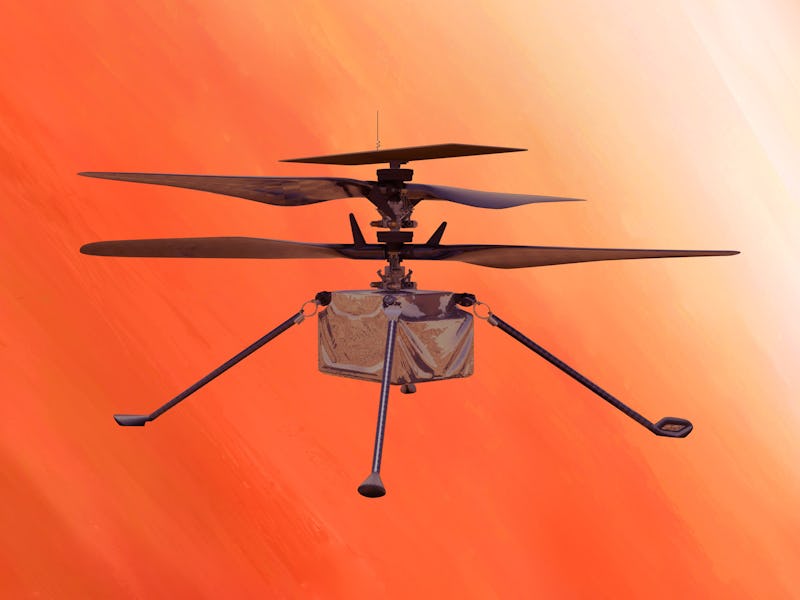Ingenuity: What if the Mars helicopter wimps out or crashes?
This tiny helicopter is a big test of the future.

Ever since NASA’s Perseverance rover landed on Mars, space enthusiasts have been rooting for the mission’s exciting sub-plot — the Ingenuity helicopter.
The historical, and tiny, aircraft is gearing up for its first test flight slated for Sunday, which will mark the first human-controlled flight to take place on another planet and open up new ways for planetary exploration.
However, should its four legs never leave the Martian ground, engineers will have to go back to the drawing board on otherworldly powered flights — with Ingenuity just the first on the horizon.
What is the Ingenuity helicopter?
Ingenuity (aka, the Mars helicopter) is the first attempt at conducting a controlled flight on another world.
The helicopter is only 19 inches tall, with two four-foot-long carbon-fiber rotors spinning in opposite directions. It weighs four pounds.
Ingenuity journeyed to Mars tucked within the underbelly of the Perseverance rover, and the pair landed on the Red Planet on February 18. After spending its first month on Mars stowed inside the rover, Ingenuity slowly untucked its scrawny legs to stand on its own.
Ingenuity unpacked its legs and touched down on the Martian surface after spending a month tucked in the rover’s belly.
Using its solar panels, Ingenuity was able to charge itself and survive on its own in the harsh, cold Martian environment — the critical first step toward being able to fly.
What is the purpose of Ingenuity on Mars?
Flying the Ingenuity helicopter on Mars is a small addition to Perseverance’s larger mission of finding ancient microbial life that may have existed on the planet billions of years ago.
However, it is no minor feat.
Paul Byrne, associate professor of planetary science at North Carolina State University, who is not involved in Perseverance but whose work relies on data gathered by prior missions, compares the Ingenuity helicopter to NASA’s Sojourner rover, the first robotic wheeled vehicle to roam another planet back in 1997.
“Sojourner didn't do very much science but it showed this kind of approach works,” Byrne says. “Ingenuity is the exact same.” Meaning: The main purpose of the helicopter is a technology demonstration, building toward bigger and better space helicopters.
Ingenuity is packed with a downward-facing camera, a radio, and four “commercial, off-the-shelf batteries that you can buy from Amazon,” according to Byrne.
If Ingenuity is able to take flight, it would prove that space engineers are now able to design aircraft that can hover over the surface of other planets with atmospheres. In order to explore Mars, NASA and other space agencies have sent spacecraft, probes, and rovers that roam its surface.
However, flying a helicopter overhead would give scientists a unique new perspective on Mars and a new way to explore the planet.
Perseverance gazes at its tiny yearling, about to take its first steps.
What if the Ingenuity copter falls over? Or explodes?
Engineers have tested out the Ingenuity helicopter on Earth using a 25-foot test chamber that simulates the Martian environment.
“Mars is a real world and everything in the real world never works the way you want it to,” Byrne says.
Mars’ atmosphere is much thinner than Earth’s, about one percent of the air pressure. It also only has about 40 percent of Earth’s gravity. This means flying a helicopter on Mars is very different than flying it on Earth.
The Ingenuity helicopter needed to be built for the particulars of the Martian environment. Ingenuity is packed with a much larger rotor, which has to be both stiff and light in order for the team to be able to control it on Mars.
However, the low temperatures of Mars could interfere, its dust could cover up the helicopter’s solar panels which would prevent it from charging, or there may be a technical issue that stops Ingenuity from taking off.
Alternatively, the Ingenuity helicopter could crash on the Martian surface, or slightly tip over and land on its side. In that instance, Byrne wonders if its rover companion would interfere and lend its robotic arm for help.
What does it mean if the Ingenuity helicopter fails?
The helicopter’s test flight has major implications for the future of space exploration. If the test flight fails, it could set back a timeline on Mars exploration beyond rovers or even possibly building permanent base camps on Mars or other worlds. In addition, upcoming missions like NASA’s Titan Dragonfly, which seeks to fly a drone on one of Saturn’s moons, won’t have useful data to build upon.
“I think it really depends on why it doesn't work,” Byrne says. “Is it that they just somehow missed something in terms of the design of it or is it just that something broke?”
If the engineers can determine what went wrong and can fix it, then another model may soon be built. However, if the reason it fails remains unknown, then it may be a “showstopper,” according to Byrne.
What’s next for the Ingenuity helicopter?
Over the course of 30 Martian sols (a sol, the equivalent of a day, on Mars is about 40 minutes longer than a day on Earth), a team of NASA engineers on the ground will test out Ingenuity's ability to fly. But they're going to take things slow.
For its first flight, the helicopter will lift a few feet off the ground and hover in the air for around 20 to 30 seconds.
Although brief, those first seconds of flight will be a major milestone in space exploration. Subsequent flights will attempt further distances and higher altitudes than the one before it.
The helicopter could fly for up to 90 seconds, to distances of almost 980 feet at a time and about 10 to 15 feet above the ground.
This article was originally published on